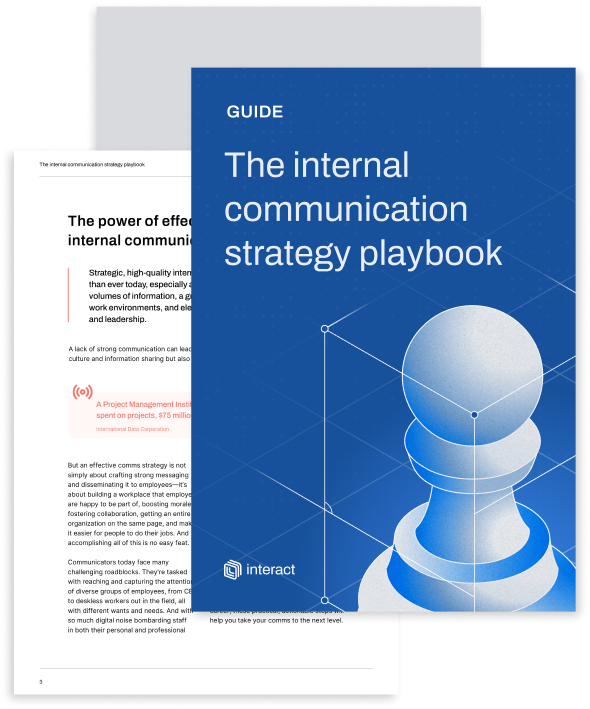Employees are a business’s greatest asset. Reliable workers will keep operations running smoothly and make every effort to excel in their designated role. Not only that, but employees know the inner workings of an organization better than anyone. Thus, they can drastically support marketing and recruitment efforts that will transform any intranet-based engagement strategy.
Creating a culture of employee-centric content is a crucial technique for increasing engagement within a business. Happy employees are more inclined to share and interact with company-related content promoting internal events, such as team-building days. This lets colleagues provide a snapshot into their work environment with a flair of individuality and personality. Generating and promoting employee engagement ideas is a fantastic supplement to any internal communication strategy and can support a business in many different ways.
What is employee-centric content?

Employee-centric content is quite simply content that is created for or by the employees. This could take the form of a blog, a social media post, a video, or a more unusual format, depending on the business requirements.
Using employee-centric content in a strategic and controlled way increases employee advocacy and brand awareness.
Often, this employee-centric content is shared on social media, on a personal or professional account, or through a company-wide intranet. It gives the outside world a window of the daily work life for staff. When done correctly, employee-centric content is an insightful look at the employee experience. It can be applied as an effective recruitment and talent retention tool.
Using employee-centric content in a strategic and controlled way increases employee advocacy and brand awareness. When promoted externally, it showcases the business’s professional atmosphere. Including it as part of an internal communication strategy increases team collaboration and camaraderie within an organization.
Involving employees in content creation can be as simple as inviting them to like or comment on a brand’s social media post or requesting a review on a site like Glassdoor. Of course, the overarching communication strategy delves a lot deeper, but encouraging this interaction can set the wheels in motion to start collecting and curating valuable employee-centric content.
What are the benefits of employee-centric content?

Organizations improve and evolve by listening and adapting to employee feedback. Inspiring the creation of employee-centric content business-wide supports this process. Encouraging workers to communicate and collaborate increases autonomy, improves innovation, and provides a new perspective with fresh thinking ideas.
Promoting employee-centric content with an advocacy approach has many benefits in retaining employees and even attracting new customers.
Companies that get this right will enjoy plenty of benefits, such as:
– Increased employee advocacy and more brand ambassadors

Who has the best insights into the daily running of an organization? It is the employees, of course. Encouraging employee advocacy across all levels, and not just from the senior leadership team, breeds trust from the audience. Brand ambassadors take many forms. Those who hold helpful and unique insights about an organization can be a valuable asset to the marketing and recruitment teams.
Developing top talent in this way can be invaluable to use as a future brand ambassador.
Correctly placed employee-centric content will showcase each team’s strengths, increasing innovation, collaboration, and overall performance. It will encourage good communication amongst multiple departments, which is vital to an efficient business flow. If done right, internal communications can inspire employees to pay attention to new company initiatives, promote brand messaging, and possess a better understanding of the values.
14 steps to great internal communications
Taking this step to include employees in the comms strategy increases their connection to the workplace and other teams. Staff feel like an extended embodiment of the values, which is a great way to create loyalty. Some employees might even want to build up their own personal brand and professionally represent the organization, perhaps with an event speaking slot, some LinkedIn video content, or as a thought leader. Developing top talent in this way can be invaluable to use as a future brand ambassador.
– Drive brand awareness

For both customers and potential hires, brand awareness is a valuable asset that can be heavily supported by employee-centric content. Suppose an organization spends time investing in employee-centric content, both internally and externally. It allows them to reach and influence target audiences and potential customers organically, with fresh faces, different perspectives, and new ideas.
Some companies understandably have a strict handle on their brand guidelines for posting externally. But when employees write positively about their professional environment, it creates trust from a brand perspective. Employers that are talked about genuinely and conversationally by staff can make a memorable impression on the target audience. This approach appears much more natural than if the Marketing team creates external content and assets specifically designed to attract a particular demographic.
– Attract and keep top talent

Job seekers notice brands that always seem to have employees making positive digital noise, whether writing about their achievements or posting photos of a team-building event. It comes across as much more genuine than if the brand’s own social media was self-promoting. Utilizing employee content is a fantastic way to attract top talent and appear like a valuable company that appreciates its employees.
It can also help attract a better talent pool if you base some employee-centric content on the main business values, helping to drive them throughout the organization and showcasing a unique work culture with values as an overarching strategy across all areas of the business.
Similarly, companies that offer a good level of collaboration and a culture heavily influenced by employees can often enhance loyalty without spending too much on extensive benefits packages. Listening to employees and appreciating their suggestions goes a long way. To many, this is more important than working for a company where they do not feel respected. Many will leave a business culture they do not like rather than stay simply for a paycheck.
– Promote autonomy and productivity

Employee-centric content is also a fundamental way to create productivity within the workplace.
Business transparency plays a large part when creating a successful employee-centric workplace and promoting this through content. Operating in this way gives employees the autonomy to make their own professional decisions by providing them with all of the information they need about an organization’s workings and current status. Giving them this trust and responsibility allows free-thinking and innovation, helping teams develop unique concepts and outside-of-the-box ideas.
Employee-centric content is also a fundamental way to create productivity within the workplace. Communication and openness in an internal strategy encourage workers to be more invested in their position and more likely to stay at the business long-term. When employees feel appreciated, productivity and attentiveness within the role increase tenfold.
How can intranet analytics support engagement?

In a survey by Deloitte, 94% of executives and 88% of employees stated that a distinct workplace culture is essential to creating a successful business. So, the importance of establishing the ‘right’ cultural values cannot be overstated, and intranet engagement plays a big part in this.
Drawing up a plan of action to create an employee-centric work environment and internal communication through an intranet is an excellent way to start. But how can an organization keep employees informed without pushing them into information overload? Well, that’s where intranet analytics play a crucial part.
Analyzing the intranet’s performance highlights any high-performing content.
Using an intranet with thorough analytics provides data that back up communication strategies with valuable insights on content performance. It’s simple to identify popular content areas and search terms and see how many people are reading certain blogs by specific team members.
Analyzing the intranet’s performance highlights any high-performing content. It pinpoints any areas for improvement and identifies everyday user journeys within the organization, empowering internal comms professionals to take up new strategies through these informative datasets.
14 steps to great internal communications
With accessible dashboards that can filter content by team, topic, and employee, doing a deep dive into the back-end insights provides a detailed analysis that exposes any behavior patterns. Using these filters helps to identify any areas of the business that aren’t engaging with the content, which could show they are not happy at work, are switched off within their team, or perhaps are undergoing a particularly stressful time. These statistics improve internal processes and workflows, creating an employee-centric workplace based on data-driven assumptions and observations.
Checking the pulse of an organization

Analytics aren’t the only way to get a handle on the intranet’s inner workings and employees’ response; Pulse surveys offer further internal insights. Tailored surveys allow employees to give honest and anonymous feedback. Organizations can then review the data and take prompt action when things aren’t working right. Pulse surveys provide an immediate understanding of how employees feel and are an overall measure of team engagement in their daily tasks.
Examining and measuring engagement provides real-time insights on employee sentiment and how content is resonating within the workforce. Interpreting and spotting trends and areas of concern take the hard work out of analysis and action plans, allowing for effective measurement of how employees respond to any newly implemented company actions. This provides a way of managing and addressing any organizational strategy based on employee-centric content and communication.
Timing is everything

One critical and often overlooked part of delivering successful internal communications is timing. To maximize engagement, create a communication schedule and carefully plan what information needs to go out and the optimal release time. It can help to test communication engagement at different points in the day, to find out what works best.
After all, is the content truly employee-centric if no one is reading or engaging with it?
For example, posting an important company update at 5 pm on a Friday may not be read as widely and thoroughly as one sent out at 10 am on a Monday. Some people have increased focus in the morning or at the start of the working week, and are therefore more likely to check the company intranet or read through a CEO update. But this is by no means universal, particularly in a company that spans multiple time zones, and pulling data from intranet analytics can help pinpoint that sweet spot of content engagement time.
14 steps to great internal communications
With any communications that promote a fun message or those that require social interaction, lunchtime may be a better choice. As always, context is everything. Avoiding national holidays and keeping an ear to the ground to tailor those communication release times can significantly impact the results. After all, is the content truly employee-centric if no one is reading or engaging with it?
If content cannot be missed and must go out at a non-optimal time, make it a ‘mandatory read’. This emphasizes to employees that this is an essential business message. It must be read as soon as possible, without significant delay. Although effective, it’s not advisable to send out multiple reoccurring pieces of content in this way. It takes the enjoyment and autonomy out of communications if employees feel as if they have been coerced into engaging.
Finally, don’t force it

Most organizations have an untapped market within their employee communication strategy, and utilizing this can unlock a brand’s potential. However, it’s essential this happens organically and is not introduced as compulsory for all staff. Making internal comms fun and encouraging involvement through initiatives and peer-to-peer recognition is traditionally a much pleasanter way to strategize. It will likely end up with more long-term success.
Combining an intranet with an employee-centric content strategy builds a workforce community, wherever they may reside in the world. It creates employee advocates and brand ambassadors that embody the company values and spread them through all areas of the business. Employees are seen as an asset, increasing the company’s credibility and building trust externally with customers and new talent. With advocacy comes a strong culture, which will support the business with sustainable growth for many years to come.


